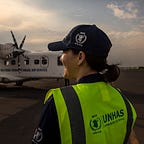‘Busy, busy, busy’
A day with the UN Humanitarian Air Service in Rumbek, South Sudan
The dust kicks up as the helicopters move toward the runway. One after another they are airborne, fading into the skies. Still on the ground, a small airplane waits for its passengers to arrive on the flight from Juba in the next few minutes and another helicopter readies for its flight. This is Rumbek, the second busiest hub for the United Nations Humanitarian Air Service (UNHAS) in South Sudan.
Seven aircraft are based in Rumbek — four that transport passengers and light humanitarian cargo for UNHAS, two that send WFP food to vulnerable communities for WFP Logistics, and another that sends non-food items on behalf of the Logistics Cluster. From Rumbek, humanitarians can fly to over 20 hard-to-reach destinations. On any given day, more than 100 people and 11 metric tons of cargo arrive, depart or pass through the hub.
In Rumbek, the day begins early, around 06:30 am. The first thing Joaquim, an Aviation Officer from San Antonio, Texas in the U.S., does when he wakes up is look to the sky — are there rain clouds, is it dusty, is there poor visibility? The weather has a big impact on operations and can completely change the plan for the day. After sending a weather report to colleagues, the next step is to check the flight schedule and brief the team on the plan for the day — all before 7:30 in the morning. After that, the team heads to the airport where the first helicopters are getting ready for departure.
By 8:30am, the helicopters carrying non-food items and WFP food are airborne and the team prepares for the arrival of passenger planes from Juba. Planes carrying between 12 and 70 passengers may arrive at one time and so the team quickly organizes arriving passengers, directing connecting passengers to their next plane or helicopter, showing others to the terminal, checking-in passengers for their flights, making sure cargo and bags are put on the correct plane, etc. In the afternoon, the team repeats this process again, welcoming humanitarians from the field and sending them onward to Juba. In the words of David, a Helper from South Sudan, Rumbek is “busy, busy, busy”.
But in South Sudan, where the rainy season lasts from May to November and the security situation can change quickly, you should “always expect the unexpected,” Joaquim says. A hard-to-reach airstrip may be flooded, an emergency may require the diversion of a plane or helicopter to facilitate a medical evacuation or security relocation, an aircraft may have a technical issue that requires the team to find quick solutions. It requires non-stop coordination to make sure that “our passengers and aircraft crew are safely transported without any problem,” according to Joseph, an Air Movement Assistant from South Sudan.
Making the operation possible is a dedicated team of more than 20 staff, mainly from South Sudan, overseen by Gerry, a South African who has been in South Sudan and Sudan for many years. Keeping the operation secure is Jose, coming from the islands of Cape Verde. Together, they work to get humanitarians and their supplies to their destinations safely and securely — always with a smile and a warm welcome to passengers.
“I love aviation, but I also love to serve. I like to do something useful and here, I feel very useful working with UNHAS,” says Nelson, an Aviation Officer from Uruguay, describing what motivates him. For Joseph, it is not just aviation that he loves but meeting people from different backgrounds, different countries and working together as a team.
The day wraps up late in the afternoon, with all flights on the ground by 05:00 pm. The team closes out the day with some paperwork and starts to think about the next day, beginning the cycle anew. As David said, “we will be ready, waiting for you at the airport.”
UNHAS South Sudan provides common air services for the humanitarian community with a fleet of 14 aircraft — 10 fixed-wing and 4 helicopters. As one of the few reliable and safe air transport services in the country, UNHAS transports approximately 300 registered humanitarian organizations to over 55 locations across the country. In 2018, UNHAS transported over 98,000 passengers and over 1,500 metric tons of light humanitarian cargo. In addition to the UNHAS fleet, UNHAS oversees all technical components of WFP air assets including those for food airdrops and food deliveries under WFP Logistics and those that deliver non-food items under the Logistics Cluster.
The work of UNHAS in South Sudan is made possible by the generous support of its donors, including Canada, the European Union, Germany, Japan, the South Sudan Humanitarian Fund, the United Kingdom, and the United States of America.
Learn more about UNHAS
